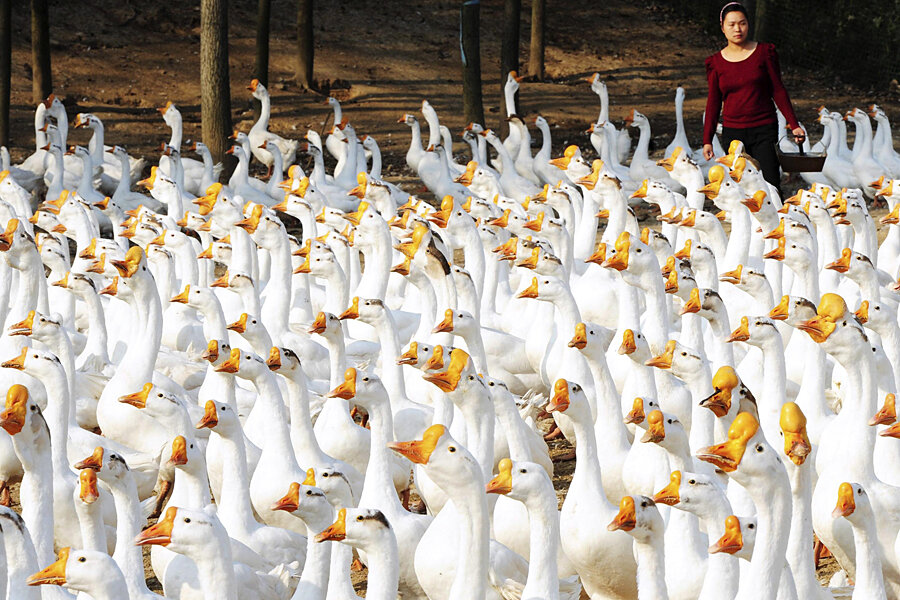'12 Days of Christmas' gifts cost $116K. 'Geese-a-laying' prices surge 74 percent.
Loading...
Those hoping to give their true love a few turtle doves or French hens for Christmas will have to shell out extra this year.
Financial firm PNC Wealth Management has once again released its annual “Christmas Price Index” (CPI), not to be confused with the consumer price index. The CPI calculates the monetary value of all the items listed in the “12 Days of Christmas” carol. A partridge in a pear tree, for example, will set you back $207.68 this year – $20 for the partridge, and $187.68 for the pear tree, a 3.8 percent increase over last year. “Housing and fresh fruit prices have been up recently,” the report explains.
Overall, prices were relatively stable year-over-year. A full set of the gifts (one partridge, two turtle doves, three hens, and so on) would cost $27,673.21 in stores, a 1 percent increase over 2013. Purchasing all items each time they are mentioned in the song – 364 gifts in total – would cost $116,273, a 1.4 percent increase over last year. Even swans a swimming, historically the index’s most volatile category (so much so that PWC also calculates a “core index” that excludes the swans category) went unchanged from 2013.
What little volatility there was came from other birds listed in the song, particularly fowl. Geese-a-laying costs soared 74 percent, while partridges and French hens jumped 33.3 percent and 10 percent, respectively.
PNC began tracking the Christmas cost index in 1984, it says, in part to keep its investors entertained during the slow holiday months. Since then, the CPI has increased 118 percent, while overall inflation has risen 127 percent. “While there are exceptions in given years, what’s most interesting about the index’s history is that since the beginning, year-over-year increases have averaged 2.8 percent, which is exactly the same number as the US inflation index,” Jim Dunigan, PNC’s chief financial officer, said in the release.
The index, of course, is more a fun diversion than anything else, but the research behind it is still exhaustive and diligent. Prices are culled from a wide array of sources, like the National Aviary of Pittsburgh (for doves and swans), the Pennsylvania Ballet company (nine ladies dancing), a plant nursery (for the pear tree) and a national jewelry chain (for the five golden rings).
Despite its limited scope, the CPI can tell us a lot about the dynamics of the overall economy. Food prices (including poultry) have been on the rise this year, but stagnation in energy and labor prices have kept overall consumer costs relatively flat. Of the “gifts” in the carol that require human labor, only “ten lords a leaping” saw a price increase. “Eight maids a milking,” the one gift involving unskilled workers, was also the cheapest, at $58 – the study assumes the maids make minimum wage.
And despite the increasing role of e-commerce in the consumer economy, goods and services bought online are still far more expensive than those bought in person. On the Web, the “12 days of Christmas” gifts cost 8 percent more than they did a year ago.
The full list of prices from PNC are below:
— Partridge, $20; last year: $15
— Pear tree, $188; last year: $184
— Two turtle doves, $125; last year: same
— Three French hens, $181; last year: $165
— Four calling birds (canaries), $600; last year: same
— Five gold rings, $750; last year: same
— Six geese-a-laying, $360; last year: $210
— Seven swans a-swimming, $7,000; last year: same
— Eight maids a-milking, $58; last year: same
— Nine ladies dancing (per performance), $7,553; last year: same
— 10 lords a-leaping (per performance), $5,348; last year: $5,243
— 11 pipers piping (per performance), $2,635; last year: same
— 12 drummers drumming (per performance), $2,855; last year: same








